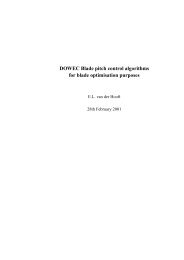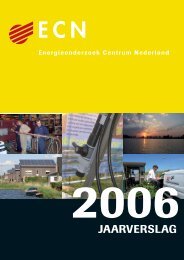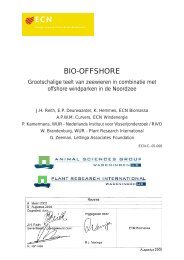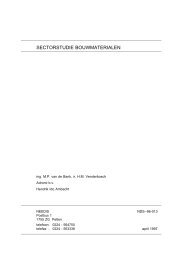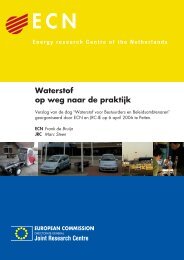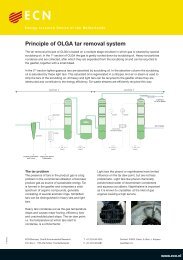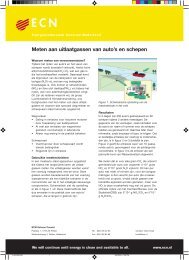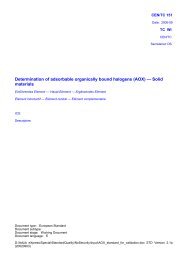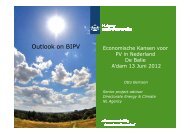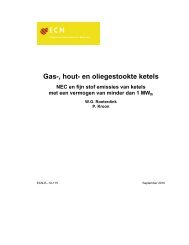PDF format (503 kB) - ECN
PDF format (503 kB) - ECN
PDF format (503 kB) - ECN
You also want an ePaper? Increase the reach of your titles
YUMPU automatically turns print PDFs into web optimized ePapers that Google loves.
5 Factor 2 or factor 10?<br />
Is it possible to reduce the CO2 emissions related to packaging use with 50% (factor 2) or is it maybe possible<br />
to reduce the CO2 emissions with 90% (factor 10)?<br />
To answer these questions we need the results of the MARKAL model. However, based on the results as stated<br />
in Chapter 4 we can try to foresee what may be the result of the implementation of various options. In such an<br />
exercise we can not take into account all the effects that different options have on each other.<br />
If we go through the packaging options as stated in table 4.1 (and background in<strong>format</strong>ion in Chapter 2 and<br />
Hekkert et al. (1998) we can see that in general the following options are possible:<br />
- Lighter packaging. This can be the result of using thinner material (foils, cans), using a different packaging<br />
shape (cans, bottles, boxes), using more efficient packaging and filling machines (boxes). To implement<br />
these options very often only small changes are necessary in the current production methods. For<br />
many packaging types that are used today, material reductions of 10 - 20% are possible.<br />
- Reusable packaging. This option has a large potential in material efficiency improvement. Reusable packaging<br />
is possible for packaging of liquids (PET bottles and refillable non-food bottles) and in the field of<br />
industrial transport packaging (industrial bags, crates and pallets). Trip numbers of 20 are not uncommon<br />
which shows the large potential of this option. The savings in material consumption (and the related energy<br />
consumption) need to be compared to additional energy requirements due to washing and extra transport).<br />
Table 4.1 shows that the reduction in material requirement outweighs the increase in CO2 emission<br />
due to cleaning and extra transport. Furthermore the reduced material costs are larger than the increase in<br />
process costs.<br />
- Material substitution. The effects of substitution options are very hard to describe in general because many<br />
different types of material substitution are possible and it strongly depends on other variables (e.g. energy<br />
consumption in material production, possibilities of material reuse etc.). In general two possible trends are<br />
visible. First it is possible to use much more natural organic materials that are renewable. These materials<br />
may be CO2 neutral and therefore attractive to use from a CO2 point of view. On the other hand these materials<br />
are often in competition with plastic packaging that can be reused which may diminish the positive<br />
effects of natural organic materials. Secondly current packaging can be substituted by light-weight alternatives<br />
(PE pouch, foils). The effects of this type of substitution depend strongly on the original material. Table<br />
4.1 shows that both options are very useful to improve the material efficiency. Only reusable packaging<br />
seems to be a better option.<br />
- Use of recycled material. In food packaging this option has limited possibilities due to regulations related<br />
to hygiene considerations. However, smart technologies make it possible to use recycled material even<br />
within this sector (e.g. multi layer PET bottles). In other sectors the use of recycled material has large<br />
potentials (pallets, crates, carrier bags). Taking into account that for plastics the feedstock may account for<br />
as much as 67% of the total energy input, energy reductions with a factor 2 are in some cases not unlikely.<br />
When we add the possibilities of the options stated above we may conclude that a reduction in CO2 emission<br />
with a factor 2 should definitely be possible for the product category packaging. We need to take into account<br />
that this only holds if we assume an equal consumption level because a strong growth in consumption will also<br />
lead to a strong growth in packaging consumption.<br />
A reduction in CO2 with a factor 10 seems not very realistic with the current identified packaging options. Even<br />
a total shift toward returnable packaging will not be enough to reach this goal. Large changes in society are<br />
necessary to reach this goal. It is beyond the scope of this paper to get into options that may result in a 90% reduction<br />
of CO2 emissions.<br />
6 Policy Consequences<br />
The packaging industry is a very dynamic and innovative sector. The sector is always trying to make packaging<br />
as attractive, easy to open and strong as possible. Their first concern is that packaging needs to protect products



